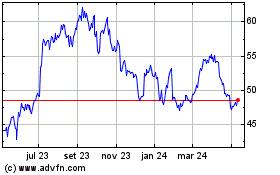Poland: Hydraulic Fracking Found Not To Affect Environment
02 Março 2012 - 10:50AM
Dow Jones News
Hydraulic fracturing conducted at a test well in northern Poland
didn't affect the quality or quantity of surface and ground water
and didn't cause tremors that would pose a threat to buildings or
other infrastructure, the Polish Geological Institute, or PGI, said
in a statement on its website.
The drilling technique, known as fracking and used to extract
natural gas locked in tiny bubbles in shale rock, did increase the
noise level in the area while it was being conducted, but didn't
pollute the atmosphere, the institute said.
Fracking has been used for decades, but concerns about its
effect on public health and the environment in the U.S. have
coincided with a dramatic increase in shale gas production. In
Poland, shale gas isn't being produced on a commercial scale, with
only a few test wells drilled so far.
Outside the U.S., Poland is one of first country where companies
are seriously attempting to develop shale gas--a development the
Polish Prime Minister Donald Tusk has called the country's "great
chance," because it could reduce its dependence on Russian gas,
create tens of thousands of jobs and fill state coffers.
Because of the dependence on Russia and an inability to import
gas from other directions, Poland pays what it sees as excessive
prices for gas.
PGI's study, which included monitoring of seismic activity, gas
emissions, noise and fluids, was based on fracking conducted
between Aug. 19-28, 2011, on test well LE-2H, belonging to 3Legs
Resources PLC (3LEG.LN). The well was 4.075 kilometers deep, with
horizontal drilling section one kilometer long.
According to the local community of a nearby municipality, Nowa
Wies Leborska, the drilling equipment isn't unsightly, the
institute said. In fact, "the [gas] flare was becoming a tourist
attraction."
The extracted fracking fluid was found to contain "significant
amounts of chemicals and toxicity," PGI said.
The fluid was under constant surveillance and wasn't able to
leak into the environment. A large part of the fluid was
transferred to another drill site to be reused to frack another
well, following a purifying process. The rest of the liquid was
transferred to a specialist treatment center, the institute
said.
Studies conducted in the second half of October 2011 showed
hydraulic fracturing at the test site didn't negatively affect the
quality of ground water in a well in the site's immediate vicinity,
PGI said.
Oil services company Schlumberger Ltd. (SLB) injected 17,322
cubic meters of water, containing 462 cubic meters of chemicals and
1,271 tons of propant, in this case sand, PGI said.
"The purpose of the sand was to prevent fractures by injecting
the high-pressure water from closing and the chemicals increased
the water's penetration, prevented bacterial flora from growing and
protected pipes from corrosion."
A Polish government geophysics institute studied seismic
activity around the site from Jul. 15-Sept. 30, 2011, in order to
record any seismic event occurring with a delay, using mobile
stations spaced from 1-25 kilometers from the drill site.
-By Marynia Kruk, Dow Jones Newswires; +48 22 447-2431;
marynia.kruk@dowjones.com
Schlumberger (NYSE:SLB)
Gráfico Histórico do Ativo
De Jun 2024 até Jul 2024

Schlumberger (NYSE:SLB)
Gráfico Histórico do Ativo
De Jul 2023 até Jul 2024
